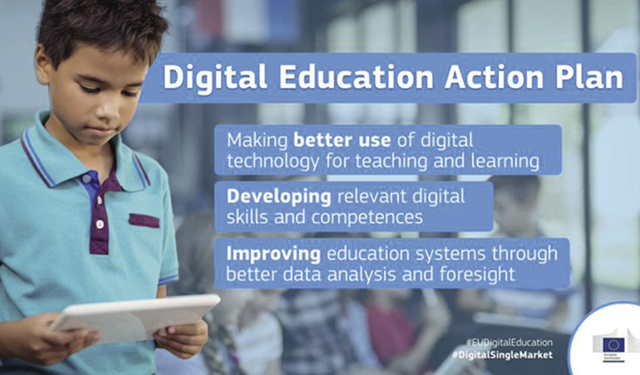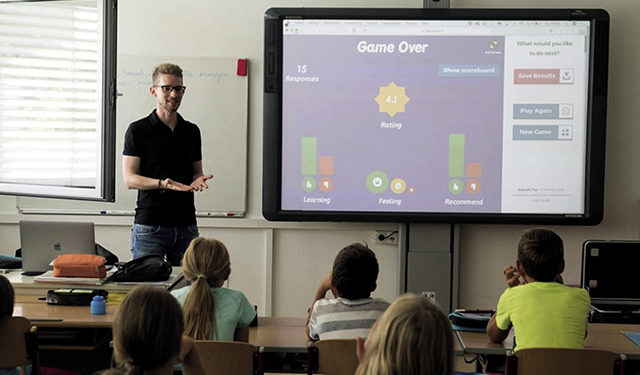To mark World Teachers Day on October 5, the European Commission launched a new online tool for teachers to reflect on how they use digital technologies in their teaching activities. Based on a series of questions, the tool, ‘SELFIEforTEACHERS’ can help them assess their digital competences and identify where they need further training and support.
Commissioner for Innovation, Research, Culture, Education and Youth, Mariya Gabriel, and Slovenian Minister of Education, Science and Sport, Simona Kustec officially launch the tool in Ljubljana.
“Teachers do an amazing job, and I want to thank them on World Teachers Day,” Gabriel said. “Digital technologies can bring about new methods for learning and teaching, and can even prove to be more inclusive and more fit to train ‘digital natives’. The tool we are launching will allow European teachers to take a snapshot, a ‘selfie’, of where they stand with technology use, and get advice on upskilling. It is important for the European Commission to accompany teachers in their lifelong learning development.”
Teachers need to prepare their students for life in a rapidly changing world where digital technologies play an ever increasing role. SELFIEforTEACHERS aims to empower teachers to build their digital capacity and use digital technologies for learning.
The tool is available in English, French, German and Slovenian. Versions in all official EU languages will soon follow.

How does the new tool work?
Any primary or secondary schoolteacher can sign-up to use the tool. Then, they react to a series of statements on their own use of technology, in six different areas:
• Teaching and learning
• Finding, using and creating digital resources
• Personalizing learning and engaging students with hands-on learning
• Assessment and student feedback
• Communication and collaboration with students, families and colleagues
• Developing student digital skills
The teacher then receives an automated report with their results (from ‘beginner’ to ‘innovator’) with suggestions on how they could level up. Using the tool can be a good first step to identify strengths and to pinpoint areas for further professional development and support. All teachers completing their self-reflection can receive a certificate and digital badge.
Teachers can use the tool either individually or as part of a team, for example, with a group of teachers within their school or with a team of subject teachers in their region or country. This can help planning within a school, network of schools, teacher education institution or local education authority.
All responses to SELFIEforTEACHERS are anonymous and no personal data is shared. The data is not designed to rank or assess teacher performance but to empower teachers to learn how they can use technology effectively in their work and how they can foster the digital skills of their students.
A pilot version of SELFIEforTEACHERS was tested with more than 4000 teachers in five countries (Estonia, Ireland, Italy, Lithuania and Portugal) this spring. Feedback was positive and teachers found the tool to be of high value and relevance to them. The Commission is working on developing resources and support material for teachers, including sharing practices from teachers who have used the tool for their professional learning.
Funded by the Erasmus+ program, SELFIEforTEACHERS was developed by the European Commission in cooperation with education ministries and experts from across Europe. SELFIEforTEACHERS is based on the European Framework for the Digital Competence of Educators, which defines the various digital skills that educators increasingly require. It sets out 22 competences in six areas with six proficiency levels from beginner to pioneer.
SELFIEforTEACHERS, is one of the 13 actions of the Digital Education Action Plan, which aims to support education systems in Europe in adapting to digital change. A key goal of the action plan is to support the effective use of technology for teaching and learning. Central to this is empowering educators to use technology in their practice.
The new tool can be used in combination with the SELFIE tool for entire school digital planning. SELFIE, which has been used by more than 1.7 million users in over 13,000 schools in 82 countries since its launch three years ago, focuses on the school as a whole. The new SELFIEforTEACHERS tool allows for a deeper dive into staff digital skills. The results can be used to identify and prioritize where further training and support is needed.
The Georgia Case
It is not yet clear if the Georgian education system will be making use of this valuable tool, but it is clear that quality education is critical for the development of both individuals and societies, helping to pave the way for a successful and productive future. Despite significant achievements in recent years, the Georgian education system continues to face many challenges. Georgia’s expenditure on education is lower than that of other countries with the same GDP per capita. The low quality of education is a major challenge for the children of Georgia, and Georgian students are seen to be underperforming in International Student Assessments.
Poor student performance can also be seen in the high dropout rate from secondary education and students’ difficulties meeting the demands of the labor market later on. The quality of education has been especially undermined by the low qualification of teachers and the ineffective system of teacher deployment and management.
In partnership with the Government of Estonia and Poland, UNICEF is supporting the Government of Georgia to strengthen the quality and inclusiveness of Georgia’s national education system. In the framework of this partnership, the new National Curriculum for primary grades was launched in 15 partner schools, introducing innovations, new learning approaches and digital technologies for education.
Sources: the European Commission and UNICEF
By Katie Ruth Davies














